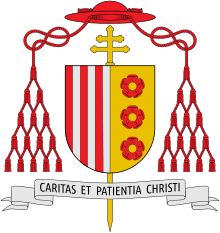Chapeau
Chapeau is a French term signifying a hat or other covering for the head.

Overview
In European ecclesiastical heraldry, it is used as a mark of ecclesiastical dignity, especially that of cardinals, where it is called the red chapeau. It is worn over the shield by way of crest, as mitres and coronets are. A galero chapeau is flat, very narrow atop, but with a broad brim, adorned with long silken strings interlaced; suspended from within with rows of tassels, called by the Italians fiocchi, increasing in number as they come lower. The hat was given to them by Innocent IV in 1250, but was not used in arms till the year 1300. Until that time, the cardinals were represented with mitres. Archbishops and patriarchs bore a green hat, with four rows of tassels; bishops wore the same color, but with three; abbots and apostolical prothonotaries with two.
The chapeau is also sometimes used as a mark of secular dignity, such as a cap or coronet armed with ermine, worn by dukes, etc. The crest is borne on the chapeau, and by the chapeau the crest and armorial shield are separated, it being a rule that no crest should touch the shield immediately.

Some forms of bicorne were designed to be folded flat, so that they could be conveniently tucked underneath the arm when not being worn. A bicorne of this style is also known as a chapeau-bras or chapeau-de-bras (literally "arm-hat").
"Chapeau!" is often used as a generic expression of approval and appreciation in France and other parts of Europe; much like the English expression "hats off!", it is a verbal equivalent of removing one's hat as a sign of admiration or respect. The expression is especially used as a sign of respect in the world of cycling, especially the Tour de France, as a way to show approval of a good performance.
Anglophone heraldries
In the Anglophone heraldries, a "chapeau" or cap of maintenance is a specific kind of hat.[1] It occurs as a charge, but also more importantly as an exterior ornament, signifying rank.
The use of the chapeau in English heraldry is not as clear cut and regulated as in Scottish heraldry.
See also
- List of hats and headgear
- Bicorne
- Tricorne
- Cocked hat
- Chapeau de Napoléon (in French)
References
- See for example the pictures and verbal descriptions in the introduction to the Lyon Court 'Information leaflet Number 2 - Crest Badges'; and examples in the coats of The Convention of The Baronage of Scotland Archived 2011-02-08 at the Wayback Machine and of Failsworth Urban District Council in England.
![]()